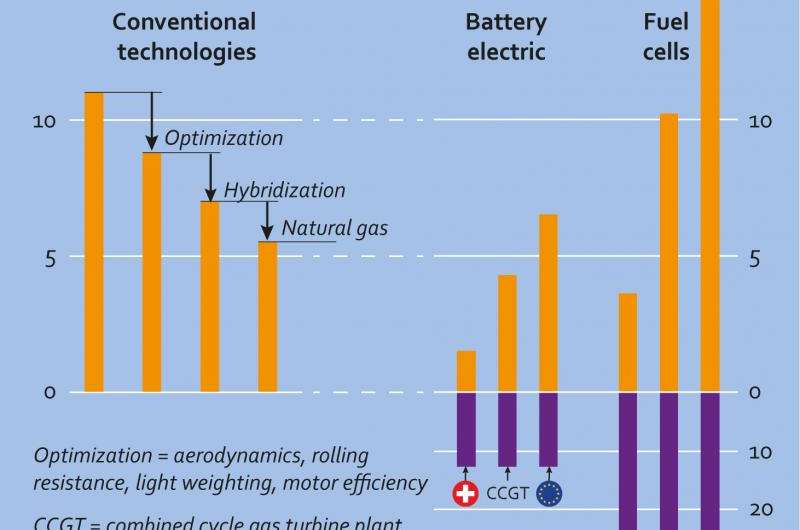Credit: Craig Adderley from Pexels
Right now, everyone is talking about mobility, how it ought to be CO2 -neutral and clean. Yet how do we get there? Banning combustion engines, changing how we usually get around or gradually shifting towards electric vehicles – the ideal path is not exactly clear.
How is Switzerland expected to manage its transport sector in the future? What options do we have and what scenarios are realistic? A working group from the Swiss Competence Center for Energy Research in Efficient Mobility (SCCER Mobility) is dedicated to addressing these issues. It recently published two reports to identify facts and opportunities.
Let's start with the facts: over the last three decades, transport is the only sector in Switzerland in which energy consumption has risen steadily. Today, it makes up almost 30 percent of the final energy consumption (not including international air transport) and accounts for roughly 40 percent of Switzerland's CO2 emissions. Within these fractions, motorized private transport (MPT) accounts for about 70 percent of consumption and emissions. If Switzerland hopes to meet the targets of the Paris Climate Agreement and the Energy Strategy 2050, all energy sectors – thus also mobility – will have to be largely CO2-free in less than 50 years.
It takes more than just changing our habits
The Federal Office for Spatial Development (ARE) forecasts an increase in the demand for transport services from 0 to 40 percent by 2040. It is interesting to consider how the willingness to change our behaviour might affect our carbon footprint. For this reason, we reviewed various scenarios and their potential to reduce emissions in our study.
An example: if all commuters in the five largest Swiss cities switched entirely to using public transport, CO2 emissions could theoretically be reduced by about 16 percent. However, this would require an increase in the public transport capacity of about 50 percent. A similar picture emerges if people were to ride bikes or e-bikes to travel any distance of less than 10 km: in the best-case scenario, CO2 emissions could be reduced by about 8 to 19 percent. However, realistically the reduction would be in the low single digit range if no sacrifices are made in terms of comfort.
Demand for electrical energy and CO2 emissions resulting from “evolutionary” (left) and “revolutionary” technology development (right). The carbon footprint is highly dependent on the production source of electricity. The estimated value of CO2 emissions from the EU export electricity mix is based on data from 2014. Credit: ETH Zurich
What technology can achieve – two paths
Now let's turn to foreseeably available technologies: optimization of engines and vehicles, hybridization and a switch to natural gas would allow a reduction in the CO2 emissions of new vehicles (covering today's transport demand) of about 50 percent in the short to medium term (five to 15 years). This translates to a decrease from approximately 11 to 5.5 million T CO2/year (see figure, left). This is what we refer to as the "evolutionary" path.
The "revolutionary" or rather disruptive path would involve large-scale electrification of powertrains through batteries and fuel cells – as several European countries are considering. However, as soon as we embark on a path towards electrification, substantial additional quantities of electricity are required. It can be said that electrification will not have a clearly positive impact on CO2 emissions compared with the "evolutionary" path unless the electricity comes from renewable sources. In the case of battery electric vehicles, power from combined cycle gas turbine plants is slightly better; power from the EU export electricity mix scores somewhat worse than the "evolutionary" path (see figure, right). In the case of fuel cell vehicles, the comparison is even more unfavorable in terms of CO2 emissions.
However, in these calculations only the CO2 emissions from operating the vehicle are taken into account. If the CO2 emissions from production (which occur largely outside the country) are added, lifecycle analyses show that total CO2 emissions of the MTP today are about 14 million T CO2/year. If the electricity used for electro mobility were to come entirely from renewable sources, it would be a good start – but without "decarbonising" industrial processes, the share of emissions from MTP would not drop below 4 million T CO2/year in this case either. Conclusion: unfortunately, it is not enough to simply do without the combustion engine, as many countries are contemplating.
Autonomous cars will not solve the CO2 problem
Much discussion recently has centred on the potential of fully automated driving to improve efficiency. Although car and ride-sharing may indeed lead to fewer and lighter vehicles on the road, it is possible that the associated advantages of cost, time and convenience would increase the demand for transport services. At present, it is unclear what will ultimately prevail, which is why we do not expect autonomous cars to have a substantial impact on the energy and climate challenges associated with mobility.
And who will pay?
There are big hurdles to overcome to reach a CO2-free transportation system – this not only from a technical standpoint. How we transform today's mobility system in the most cost-effective way will be crucial. Therefore, SCCER Mobility is currently increasing its socio-economic research efforts.
It is already clear that in addition to the CO2 regulations for vehicles on the road, it will be critical to take all external costs (for the environment, safety, infrastructure) into account. This is the only way to ensure pricing that reflects actual use and cost-effective CO2 reduction paths. This is not currently the case; for example, if CO2 emissions from electricity production are ignored in the CO2 regulations for electric vehicles. However, it is important to have a level playing field for different technologies. Well-targeted steering-based policies can achieve this much more effectively than subsidies.
More information: Towards an Energy Efficient and Climate Compatible Future Swiss Transportation System. www.sccer-mobility.ch/export/s … ionSystem_Ver1.2.pdf
Opportunities and challenges for electric mobility: an interdisciplinary assessment of passenger vehicles. www.psi.ch/lea/HomeEN/Final-Re … t-THELMA-Project.pdf
Promotion-or Steering-based Energy Policy: Assessing Efficiency and Distributional Impacts. www.ethz.ch/content/dam/ethz/s … STEP_Report_LONG.pdf
Provided by ETH Zurich
























